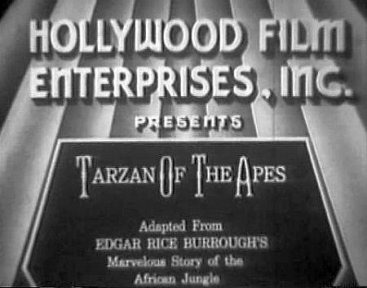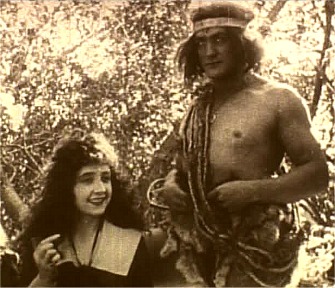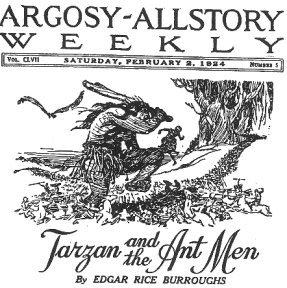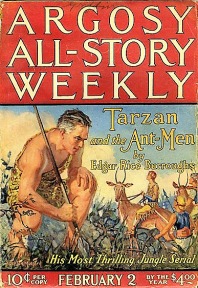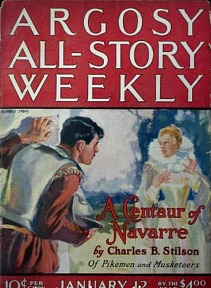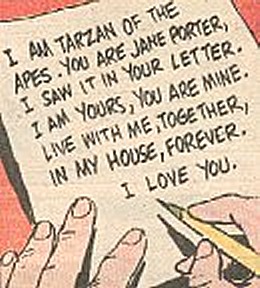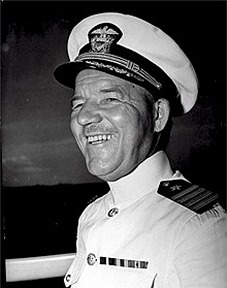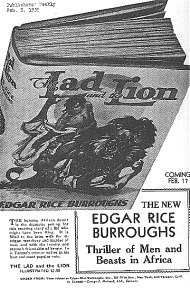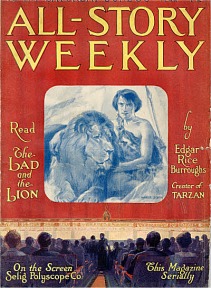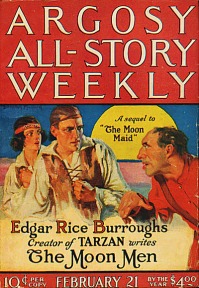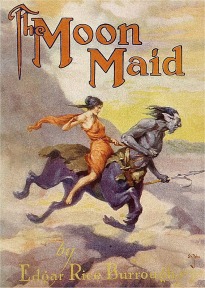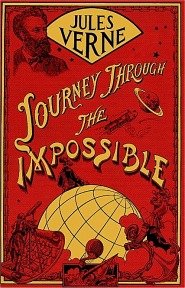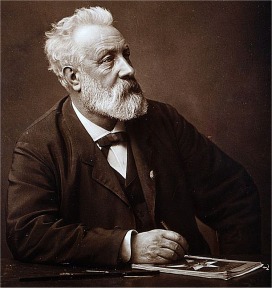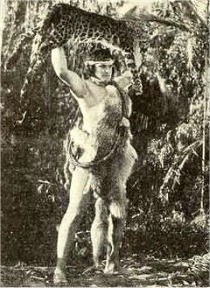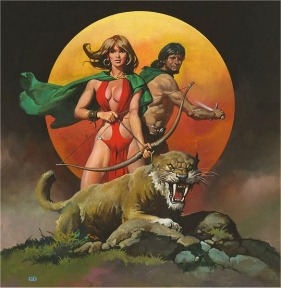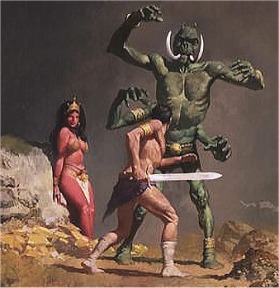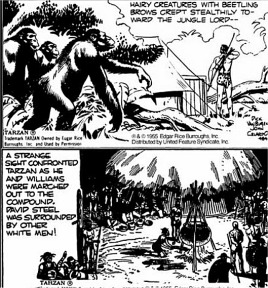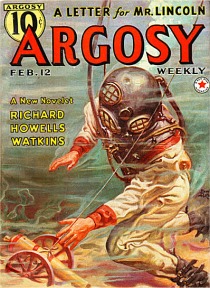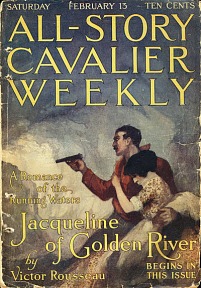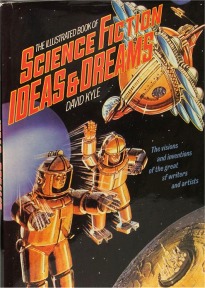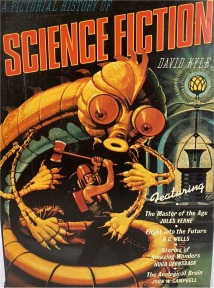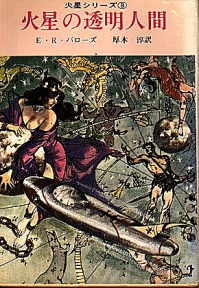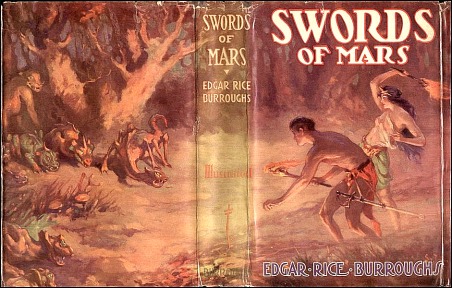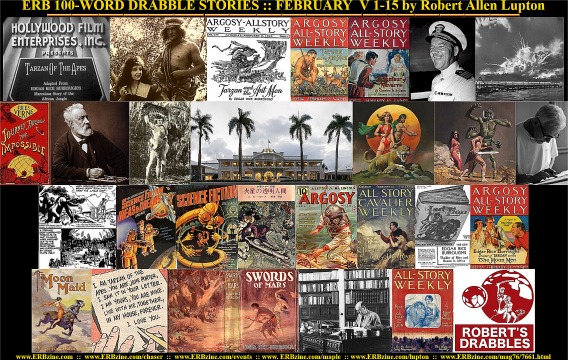
Official Edgar Rice Burroughs Tribute and Weekly Webzine Site Since 1996 ~ Over 15,000 Webpages in Archive Volume 7661 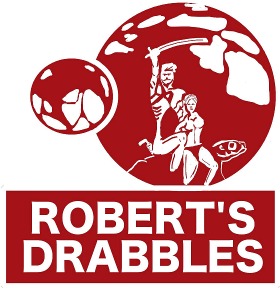 |
ERB 100-Word Drabbles
FEBRUARY V Edition :: Days 1-15
by Robert Allen Lupton
See Days 16 - 28 at ERBzine 7661a
With Collations, Web Page Layout and ERBzine Illustrations and References by Bill Hillman
PLOT HOLES
February 1: On this day in 1919, Variety, the magazine/newspaper serving the entertainment industry since December 16, 1905, published a review and synopsis of a new ten reel film, Tarzan of /the Apes starring Elmo Lincoln and Enid Markey. The review wasn’t particularly flattering. Everyone's a critic.
You can read the entire review and a lot more about the film at: https://www.erbzine.com/mag5/0503.html
The drabble for today is, “Plot Holes,” and it is 100 words from the Variety review of February 1, 1919.'None of the real mystery is cleared up, at least the mystery fostered in the picture. The audience is left in the dark as to whether or not he has come into his birthright, whether he has won the girl or not, or, if he has, did he keep her in the jungle wilds and how he learned English. "Tarzan of the Apes" is a freak picture that will cause talk, but needs cutting. When it’s chopped for more speed and action and can be shown in an hour and a half it will be more worthwhile than at present. PLOT HOLES
WHAT, ME WORK?
February 2: Groundhog Day ~ On this day in 1923, the first installment of “Tarzan and the Ant Men,” was published in Argosy All-Story Weekly with a beautiful cover by Stockton Mulford. Roger B. Morrison drew the interior illustration for “His Most Thrilling Jungle Serial” according to the cover blurb.
The issue also contained the 8th installment of “Hopalong Cassidy Returns” by Clarence Mulford and part four of the “Centaur of Navarre” by Charles B. Stilson (Polaris of the Snows.) I’ve included the Modest Stein cover for “Centaur of Navarre” with this post.
Publishing details, illustrations, and a wealth of information about "Tarzan and the Ant Men" https://www.erbzine.com/mag4/0497.html
ERB wrote Ant Men from June to December 1923 and this marvelous story contains more than a little of ERB’s thinly disguised social satire. America was dealing with prohibition and the early years of income taxes and Burroughs attacked both in this novel. His satire isn’t as ‘in your face’ as Swift’s “Gulliver’s Travels,” but it’s more than direct enough to get his discontent with the government policies across to the reader.
The drabble for today, “What, Me Work?,” was inspired by ERB’s social commentary in “Tarzan and the Ant Men.”Tarzan was reduced to six inches tall and befriended Prince Komodoflorensal, who was imprisoned with him. The Prince said, “Once we escape, we’ll go to my country. Things are different there.” WHAT, ME WORK?
“Is slavery allowed?”
“Not exactly, but everyone is taxed according to how much they earn in order to support the government. The more you make, the more you pay.”“Not a policy to inspire a man to work, more likely to drive him to drink,” observed Tarzan.
“Alcohol is prohibited.”
“Sounds charming, wage and tax slavery are enforced and alcohol is illegal. You escape. I’d rather stay in prison.”
JANE'S LETTER
February 3: On this day in 1909, Jane Porter, who was stranded in Africa with her father’s expedition, wrote a letter to her friend, Hazel Strong, who lived in Baltimore. The letter is in the novel, “Tarzan of the Apes,” chapter seventeen. Jane confesses that she isn’t entirely sure of the date and even put a question mark after it in the letter. Tarzan watched Jane write the letter. He took it and read it in the next chapter. He was inspired to write a letter back to Jane, in which he proclaimed, “I am Tarzan of the Apes.”
Massive details and information about the novel, “Tarzan of the Apes,” abound at: https://www.erbzine.com/mag4/0483.html
The drabble for today is 100 words taken from Jane’s letter to Hazel Strong.The strangest part of it all is the wonderful creature who rescued us. I haven’t seen him, but Mr. Clayton and papa and Mr. Philander say that he’s a perfectly god-like white man with the strength of a wild elephant, the agility of a monkey, and the bravery of a lion. He speaks no English and vanishes quickly after he has performed some valorous deed. JANE'S LETTER
We’ve another weird neighbor, who printed a beautiful sign in English and tacked it on the door of his cabin warning us to destroy none of his belongings, and signing himself "Tarzan of the Apes."
A CONFUSED OLD MAN
February 4: On this day in 1943, Edgar Rice Burroughs, the world’s oldest war correspondent was attached to the USS Shaw. That morning, the Shaw left Suva, Fiji’s capitol for Pago Pago on the island of Tutuila in American Samoa. The USS Shaw was escorting a tanker, “The Gulf Queen.” The Shaw had suffered heavy damage during the attack on Pearl Harbor, but was repaired and refitted. The ship was decommissioned in 1945.
The governor for American Samoa was a friend of ERB’s, Edward William Hanson, a man who admired the Samoan way of life and didn’t interfere with the established practices on the island. Hanson was awarded the Navy Cross during WWI and he retired with the rank of vice-admiral in 1951.
The trip to American Samoa didn’t go as planned. The drabble for today is one hundred words from Burroughs’ entry for February 4, 1943 in his “Diary of a Confused Old Man.” The entire diary entry is available at: https://www.erbzine.com/mag68/6840.html“The lookout reported six ships just below the horizon. They later became nine ships, which finally developed into a squadron of SC boats, sub chasers. A CONFUSED OLD MAN
"About 11:30, a message was brought down from the communications officer, an order for us to return to Suva with our convoy. The Gulf Queen, the McKean, and the Shaw came about and zig-zagged in the opposite direction. We dropped anchor again in Suva harbor at 5:30 PM. Shortly after, a message from shore said a hurricane was forming about 150 miles NE of Suva. I thought we might get some excitement after all.”
YOU NEVER EVEN CALL ME BY MY NAME
February 5: On this day in 1938, Publisher’s Weekly ran an advertisement for Edgar Rice Burroughs’s new book, “The Lad and the Lion.”
The story was first serialized in All-Story Weekly in 1917, and the first installment coincided with the film, “The Lad and the Lion” produced by the Selig Polyscope Company, which paid ERB $500. The Lad and the Lion had the distinction of having its premiered on May 14, 1917 to coincide with publication of the story in All-Story Weekly.
Unlike most of ERB’s novels, “The Lad and the Lion” did not appear as a book until almost thirty years later after Burroughs added another 21,000 words to the story and it was published by ERB Inc. with a cover by John Coleman Burroughs.
See the entire advertisement at: https://www.erbzine.com/mag4/0450.html
Publishing details about “The Lad and the Lion” and several related illustrations are located at: https://www.erbzine.com/mag7/0760.html
The drabble, “You Never Even Call Me By My Name,” for today was inspired by the novel, “The Lad and the Lion.” Credit for the title goes to singer/songwriter, Steve Goodman, for his song recorded by David Allan Coe.Nakhla, the beautiful daughter of an Arab sheik, had been rescued by Michael, a young man who’d been kidnapped as a child. He was cast adrift on a raft with an African lion. YOU NEVER EVEN CALL ME BY MY NAME
Nakhla taught Michael to speak and named him Aziz, because he didn’t remember his name. She asked, “Aziz, you and this lion lived on a raft?”
“There was an old man, but he died. The lion’s my brother.”
“Why didn't you have names?”
“No need. Lions can’t talk, and since he was the only other one there, whenever I spoke, he knew I was speaking to him.”
FROM EACH ACCORDING TO OUR GREED
February 6: On this day in 1926, A. C. McClurg published the first edition of “The Moon Maid” with a cover by J. Allen St. John. The novel was written and published in three parts by Argosy All-Story Weekly from 1923 through 1925. Each part tells the story of one of the incarnations of Julian, a man who can remember his previous lives and foresee his future lives.
Burroughs wrote the second part of the novel using the working title, “Under The Red Flag,” before he wrote the first part, “The Moon Maid.”
“Under the Red Flag,” aka “The Moon Men,” was inspired by the Bolshevik revolution and Burroughs's distrust of communism.
Predating the “Red Dawn” film by over sixty years and the novel “Animal Farm,” by twenty-five years, the story originally told of America under the control of communists. ERB changed the Russians to Kalkars, men from the moon, in order to sell the story.
Publishing details, numerous illustrations, and an electronic version of the text are available at: https://www.erbzine.com/mag7/0767.html
The drabble for today is “From Each According to Our Greed,” and it was inspired by the second portion of the “The Moon Maid,” originally written as “Under the Red Flag."Julian diligently worked his farm. General Or-tis, a collaborator with the occupying forces of the Kalkars arrived with a large force at harvest time. “Collecting taxes. They’ve been doubled. You’ve no money, and so this year the state needs seventy percent of your harvest.” FROM EACH ACCORDING TO OUR GREED
Julian replied, “That won’t leave us enough to all survive the winter. Next year with fewer workers, we’ll produce fewer crops.”
“Then we’ll raise taxes. The less you produce, the more we take.”
“Seems a bad business model. Eventually, you won’t have anyone left to tax.”
“Perhaps, but I deal with todays. Tomorrow is tomorrow’s problem.”
SLOW DOWN, YOU'RE MOVING TOO FAST
February 7: On this day in 1943, Edgar Rice Burroughs, the world’s oldest war correspondent stayed in the Grand Pacific Hotel in Suva, Fiji. He and Captain Ramsey arrived at the hotel only to discover that alcohol wasn’t served on Sunday. Ramsey hated site-seeing and preferred to find a good bar in every port and settle in. ERB inisted that the two hire a taxi and see the sites.
Ralph Lester Ramsey was promoted to Lt. Commander and nine months later, the USS McKean, while under his command, was sunk by Japanese aircraft off Bougainville Island and 64 of her crew and 52 Marines were lost. Lt. Commander Ramsey survived.
Every entry in ERB’s “Diary of a Confused Old Man” is available at www.erbzine.com and this particular entry is at: https://www.erbzine.com/mag68/6842.html
The photo is of the Grand Pacific Hotel.
The drabble for today is, “Slow Down, You’re Moving Too Fast,” and it’s a 100 word excerpt from ERB’s Diary of a Confused Old Man.” Thanks to Simon and Garfunkel for the title.“We hired a taxi and see some of the back country. I don't know whether Ramsey enjoyed the trip, but I did. SLOW DOWN, YOU'RE MOVING TOO FAST
“We made a thirty mile loop through hills and the jungle, and like all jungles that I’ve seen, it was a disappointment. They’d have been a disappointment to Tarzan, also.
We saw a young girl getting a bath by the road side. She was no child, and she was entirely naked. She stood smiling as we passed with a few feet of her. I was highly incensed. It was shocking, the speed with which our driver drove past.”
SPACE, THE FINAL FRONTIER
February 8: On this day in 1828, writer Jules Verne was born in Nantes, France. Edgar Rice Burroughs read and enjoyed Verne’s work and his personal library included "The Castaways of the Flag," "Doctor Ox and Other Stories," "English at the North Pole," "Journey to the Center of the Earth," "Tour of the World in 80 Days" and "20,000 Leagues Under the Sea." For information about ERB’s personal library, https://www.erbzine.com/dan/
Verne and ERB both wrote about trips to the center of the Earth, journeys to the moon, and adventures in Africa.
Most of us are aware of less than a dozen of Verne’s novels, but he wrote over 80 of them.
Delphi Classics has a Kindle collection available from Amazon for less than $5.00. It includes sixty-six novels and lists another 16 which have never been translated into English. The volume also includes eight short stories, three plays and four non-fiction books. I’ve been working my way through this massive volume and after three years I’m only 47% through it. (I do read a lot of other things and I never read two Verne novels in a row.) Yesterday I finished "Mistress Branican," a woman whose husband is lost in a shipwreck, but she refuses to accept his death and finds him 16 years later, held captive by Australian aborigines. Before that I read “The Carpathian Castle,” a precursor to “Dracula.”
Verne loved to travel and the 100 word drabble for today. "Space, the Final Frontier,” includes some quotes by Verne about that obsession. Note that Verne refers to space as the final frontier over a hundred years before the first line in the Star Trek intro, “Space, the final frontier,” was written was heard for the first time on broadcast television.“Young people, travel if you can, and if you cannot, travel all the same. Travel enables us to enrich our lives with new experiences, to enjoy and be educated, to learn respect for foreign cultures, to establish friendships, and to contribute to international cooperation and peace. SPACE, THE FINAL FRONTIER
“How much further can we go? What are the final frontiers in this quest for travel? Will humankind only be satisfied when journeys into space become readily available and affordable? Anything one man can imagine, other men can make real. There are no impossible obstacles, there are just stronger and weaker wills, that’s all.”
SO MANY LIONS
February 9: On this day in 1922, Chapter eleven of the Weiss Brothers’ Numa Pictures Corporation film serial, “The Adventures of Tarzan,” was released. The chapter title was “The Hidden Foe.”
Director Robert F. Hill said that this film was his greatest work. However it was plagued with problems. In one scene where Elmo Lincoln (Tarzan) fought a lion, the lion took the fight for real and Elmo had to fight for his life. They kept the cameras rolling.
A fire sequence got out of hand almost burned down the entire studio and on July 15, 1921, five actors were hospitalized and three cameras were destroyed when three lions terrorized the set. The film was filmed in California and Arizona, imagine if they’d actually filmed in Africa.
Details about the serial are at: https://www.erbzine.com/mag5/0590.html
The 100 word drabble for today, “So Many Lions,” was inspired by the dangers encountered by the crew in filming “The Adventures of Tarzan.”The producer of “The Adventures of Tarzan” confronted director Robert Hill. “Tell me again why we didn’t film on location. You damned near burned down the studio. A lion almost killed our Tarzan and three more of them rampaged all day long and destroyed the day’s work and thousands in equipment.” SO MANY LIONS
“We were better off in the studio.”
“Tell that malarkey to the insurance company.”
“Lions do whatever they want. We had six lions on set. There are thousands of lions in Africa.”“Seemed like more than six lions.”
“Yessir, but one pissed off lion can seem like a hundred.”
DAILY BREAD
February 10: On this day in 2017, artist Gino D’Achille died in London, England. Gino illustrated the covers of eleven John Carter books for Ballantine Books according to Jim Goodwin’s “Edgar Rice Burroughs The Descriptive Bibliography of the Ace and Ballantine/Del Rey Paperback Books.” ~ https://www.erbzine.com/mag71/7139.html
His international reputation grew with his 1973 paintings for the John Carter of Mars series. He created over 100 cover paintings for other science-fiction titles published by Daw Books, Ace, Ballantine, and various other publishers.
He illustrated Sherlock Holmes stories, The Jungle Book, Fu Manchu stories, Arthurian legends and the Jack Vance Science Fantasy series as well as stories by Daphne du Maurier and Mary Stewart.
He is also well known for his series of covers for the much-loved Flashman series of novels by George Macdonald Fraser, as well as countless western adventure stories, crime thriller and war stories, romance novels and children’s books.
Prints of his work are available at: https://www.ginodachille.com/ and more detailed information about the artist is located at: https://www.erbzine.com/mag70/7028.html
The drabble for today, “Daily Bread,” was inspired by an event in Gino’s early life. Credit goes to Pope Benedict XVI for last line.“Hi folks, today we’re interviewing Gino D’Achille. Now, Gino, I understand that you presented one of your paintings to the Pope when you were eleven years old.” DAILY BREAD
“Yes. It was right after World War Two. I’d painted a portrait of Pope Pius XII, and I gave it to him. He was very kind to me?”
“So you could understand what he said?”
“Of course, I was born in Rome. We’re both Italian.”
What did you think about the Vatican?”
“So big and so many people. I wondered how many people worked at the Vatican, and he said, ‘Only half of them.’”
POT BOILER
February 11: On this day in 1955, the story arc, “Tarzan and the Ubangis” began in the Tarzan daily comic strip. Art was by John Celardo and the continuity was by Dick Van Buren.
The story ran for 56 daily strips. Tarzan encounters John Williams, a man lost in the jungle and helps him save his wife, Laura Williams, from the Umbangi cannibals. Laura isn’t destined for the stewpot, but will be forced to mate with David Steel, an evil man who has somehow become the chief’s advisor.
Tarzan calls and the lions and apes respond to save the good guys (and girl) from the cannibals.
The entire story is available at: https://www.erbzine.com/mag38/3838.html
The drabble for today, “Pot Boiler,” was inspired by the storyline of “Tarzan and the Ubangis.”The Ubangi cannibals tied Tarzan to a stake. The stewpot boiled and the natives danced. POT BOILER
The chief said, “We’ll eat well tonight.”
Tarzan replied, “Cannibalism is wrong.”
The chief laughed. “Do not lions and crocodiles eat people? Are the Ubangi not as good as lions and crocodiles?"
“Who was that woman you were with yesterday?
‘That was no woman. That was our supper.”
“Was she your wife?”
“No my wife made really good soup. I’ll miss her terribly.”
“Christians claim that cannibalism is sinful.”
“I know what they say. We ate a missionary only last week. He disagreed with me.”
TRUTH IS IN THE EAR OF THE BEHOLDER
February 12: On this day eighty-five years ago in 1938, Argosy Weekly published the 6th and final installment of “Carson of Venus,” The issue’s cover was by Emmett Watson and it illustrated a novelette by Richard Howells Watkins, “Salvage Tide.” The issue also contained part three of the novel, “Golden Acres” by Luke Short, a pseudonym of Frederick D. Glidden. My favorite story title in the issue is “Neptune is an Irishman” by James Lockette Hill.
“Carson of Venus” was the third book in the Venus series. The book was written just before WW2 and it is largely satirical. It condemns fascism by attacking the Zani, an anagram of Nazi. Prior to publication in Argosy, Burroughs unsuccessfully submitted the novel to “Liberty Magazine,” “The Saturday Evening Post,” “Collier’s” and “Ladies Home Journal.”
Publishing details, an electronic version of the novel, and several illustrations are located at; https://www.erbzine.com/mag7/0750.html
One thing that ERB shared with Earnest Hemingway, other than both men serving as war correspondents during WW2 was that they both despised fascism. In “For Whom The Bell Tolls,”Hemingway wrote the following exchange. The drabble for today was inspired by “Carson of Venus.” The drabble, “Truth is in the Ear of the Beholder,” contains three quotations within its 100 words. The quotes are from Winston Churchill. Friedrich von Hayek, and Henry Wallace. I could have included quotes from FDR and Woodrow Wilson, but they were quite similar to what Churchill had to say.
“Are you a communist?"
"No I am an anti-fascist"
"For a long time?"
"Since I have understood fascism.”“The fascists of the future will call themselves anti-fascists. Fascism is the stage reached when communism has proved an illusion. With a fascist the problem is never how best to present the truth to the public, but how best to use the news to deceive the public into giving the fascist and his group more money or more power. TRUTH IS IN THE EAR OF THE BEHOLDER
Fascists are best recognized by their deliberate distortions of truth and fact. A fascist who wishes to be in power must follow two very simple rules. He isn’t tempted by needless veracity, and he is never apologizes for his unrepentant self-interest.”
LOVE AIN'T EASY
February 13: On this day in 1915, All-Story Cavalier Weekly published the fourth and final installment of “Sweetheart Primeval,” which combined with the “The Eternal Lover” made up the book, “The Eternal Lover.” “The Eternal Lover” was retitled for paperback publication in the 1960s’ as “The Eternal Savage.”
The cover illustration was by an artist, Fred W. Small, who illustrated a number of pulp covers for Edgar Rice Burroughs’s novels, but this one illustrated the first part of a novel by Victor Rousseau, “Jacqueline of the Golden River.” An installment of Perley Poore Sheehan’s novel, “Judith of Babylon,” was also in the issue, as was “The Methods of Moris Klaw: The Tragedies in the Greek Room” by some dude named Sax Rohmer (A. Sarfields Ward).
You can read the entire novel online, see the publishing history, and view several illustrations at: https://www.erbzine.com/mag7/0759.html
The drabble for today is, “Love Ain't Easy,” and it was inspired by “Sweetheart Primeval.”Everyone believed Nu killed Victoria Custer. Everyone except her brother, Barney, who believed she was alive. LOVE AIN'T EASY
Barney taught Nu English. The Caveman wanted to find Nat-al and Barney wanted to find Victoria. Neither knew they sought the same woman.
They searched for her. An Arab slaver had captured Victoria. Nu killed the slaver and professed his love.
She said, “Love will be hard. Our worlds are different.”
Nu put his spear to his throat. “Should we die and hope for love in another lifetime?”
She kissed him. “No, I said it would be hard. I didn’t say we shouldn’t try.”
TARZAN GOOD, ROKOFF BAD
February 14: 2023, Valentine’s Day and the 1700th post and drabble in this series. On this day in 1919, Science Fiction writer and historian, David Anthony Kyle, was born in Middleton, New York. Kyle founded Gnome Press in 1948 with Martin Greenberg. Kyle wrote, “A Pictorial History of Science Fiction” and “The Illustrated Book of Science Fiction Ideas and Dreams.” He also wrote three Lensmen novels, “Dragon Lensmen,” Lensmen from Rigel,” and “Z-Lensmen.” Both Pictorial History and the Illustrated Book are readily available from Amazon and Ebay. I ordered both today.
Kyle was an admirer of Edgar Rice Burroughs. In his book “A Pictorial History of Science Fiction he called Edgar Rice Burroughs, The Father of Scientifiction,” and excerpts from that book may be found at: https://www.erbzine.com/mag3/0399.html#kyle
The drabble for today, “Tarzan Good, Rokoff Bad,” was written by Donald A. Wollheim and was included in Kyle’s book."His talent was producing wonderful adventure, of building good against evil. He wasn’t a grand philosopher. He didn’t venture into deep science or propose grandiose schemes for social development. He sought to entertain and created marvels that caught the mind of the world and still do. It's old-fashioned these days. It cannot be subtracted from the reasons why Burroughs sells as well as he ever did. Tarzan is good, always good. His foes may be mixed, but his main foes are evil, downright evil. When I hear that millions of young people are reading Burroughs and enjoying him, I rejoice.” TARZAN GOOD, ROKOFF BAD
SMALL BUT FIERCE
February 15: On this day in 1936, Edgar Rice Burroughs Incorporated published the first edition of “Swords of Mars,” the eighth book in the John Carter series. The book contained 315 pages and featured a wraparound dust jacket by J. Allen St. John, who also drew five interior illustrations.
The book was dedicated to ERB’s future wife, Florence. ERB disguised the dedication. The first letter of every chapter spelled out, “To Florence with all My Love Ed”
Publishing details, numerous illustrations, and the entire book are available at: https://www.erbzine.com/mag7/0736.html
The drabble for today, “Small but Fierce,’ was inspired by the “Swords of Mars,” and especially John Carter’s visit to the Barsoomian moon, Thuria. The closer he came to the moon, the smaller he became until he arrived on the surface to find himself small enough that his height on the moon was in direct porportion to his height on Barsoom. I did the math, probably badly, but here it is. Barsoom (Mars) is 4212 miles in diameter, Thuria (Phobos) is 14 miles in diameter, or .00332 percent the size of the planet it orbits. A six foot one inch man would be ¼ inch tall if that ratio were maintained.John Carter arrived on the moon, Thuria, seeking to save his love, Dejah Thoris, who was held captive there. By some unknown phenomena, Barsoomians shrank in size as they approached the moon, as did their belongings and aircraft. SMALL BUT FIERCE
Captured, Carter was imprisoned with the catlike Thurian, Umka, and with his help escaped and saved his princess.
Dejah said, “I worried that your small size might be a problem.”
“It wasn’t. The smaller I became, the more your love and my determination filled me. There’re large men with small hearts and small men with large hearts. Always bet on the brave.”
